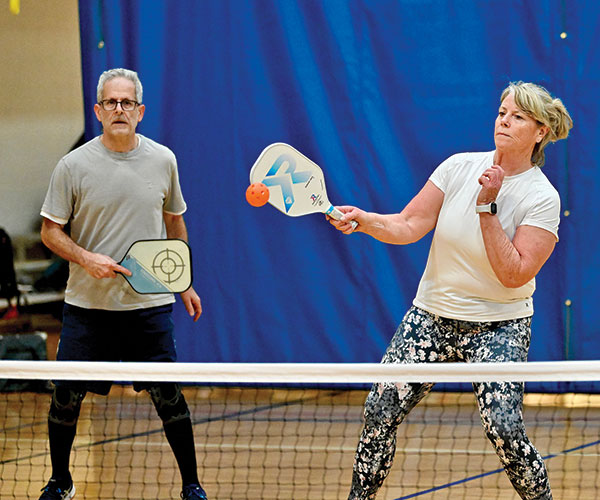The early morning ring of the phone inspired anxiety, just for its timing. And when Jane* heard the sounds coming from the other end of the line, the real panic set in. Her mother was trying to communicate, but she wasn't using real words, only intense grunts and short, choppy moans.
"MMM!"
"Mom?"
"MMM!"
"Mom, are you all right?
"MM-MM!" (No.)
"Mom, can you talk to me? Speak to me. Tell me what's happening."
"MMM! MMM!"
"Mom, you're scaring me. I'm going to call the nurse."
A loud shout — "NO!" — then, in a whisper, "Can't talk. Come!"
Jane dropped the phone and raced to the retirement community with no idea what she'd find when she arrived. What she discovered was this: Her 85-year-old mother Katherine*, tiny and frail in the hospital bed, looking crazed with eyes darting all over the room, paranoid and completely convinced that her room had been bugged, that "they" could hear everything.
She wouldn't speak until Jane wheeled her out of her room, off that floor and onto an outside balcony. Finally, Katherine explained that she wouldn't be opening her mouth as long as she's in that room — not for speaking, not for medication, not for anything. After all, you never know what they might be waiting to shove into it.
A few hours later, Jane's mother was fine, except for the broken wrist she'd suffered a week earlier. The broken wrist turned out to be the clue that helped Jane figure out what was happening to her mother. Because her wrist was in an unwieldy splint that rendered her unable to use her walker correctly, Katherine had to spend a few days in the full nursing care unit instead of in her assisted-living apartment. The broken wrist and sudden change in living environment created more stress than Katherine could handle. During the late afternoon and evening, her behavior went haywire; extreme paranoia, agitation and confusion took over. In the morning and during daylight, she seemed fine.
But the next night, same thing, followed by another daylight reprieve. Jane hired an aide to sit in her mother's room during the evening and at night.
Later, Jane would find out that her mother was "sundowning" — a term for a group of behaviors occurring in some older patients, usually those with Alzheimer's disease or other forms of dementia, around nightfall or sunset. These behaviors can include confusion, anxiety, agitation or aggressiveness, sometimes with increased pacing or wandering or yelling.
Sundowning usually happens between 3 and 7 p.m. when the light begins to lower, depending on the season. It usually recedes with the light of the following day. Some theories about what causes the phenomena include fatigue, too much stimulation, too little stimulation and seasonal affective disorder.
"It isn't caused by dementia, but people with dementia sometimes have it," says Dr. Penny Harris, a sociology professor at John Carroll University and nationally recognized editor of a journal on dementia. Sundowning also occurs in some people with dementia who are not older adults, Harris says.
The condition has sometimes been referred to as "Sundowner's Syndrome," but that designation is technically incorrect, according to Harris. "A syndrome means it's a group of symptoms that form a disease, and sundowning isn't a disease. It's a behavior that sometimes happens with people with dementia," she explains.
Sundowning is not new, but it has become more visible recently as researchers give it more attention. It's become a focus of study in the past 15 to 20 years, says Harris. But it's not yet clear how prevalent it is. Estimates cited in the journal Clinical Geriatrics of the share of older adults with sundowning issues ranged widely from 2 percent to 26 percent. Among patients with Alzheimer's disease, the range widened to 2 percent to 66 percent.
What causes sundowning? Fatigue is usually cited as a contributing factor because older adults, especially those with dementia, have more trouble processing information when they get tired. "Too much stimulation going on can cause more agitation, confusion or aggressive behavior," Harris says. "In an older adult, less and less light can also affect vision, so they might think they see things or hear things."
Manipulating the person's immediate environment is the first step in responding to sundowning, experts say, and a far better option than using medication.
"A lot of times it's [caused by] a combination of environmental things that have changed all of a sudden," says Dr. Matthew Wayne, chief medical officer of the Eliza Jennings Senior Care Network. "For example, in Katherine's case, she had the trauma of the fall, the injury to her wrist, the cast on her arm, she's in a different environment, she's on new pain medication, she has different nurses. She just needs to get back to her routine. Instead of jumping to new drugs, I'd rather look at all the factors involved and try to regain some of the familiarity and routine that she had."
Environmental changes can help most patients who are sundowning — an afternoon nap, fresh air and sunlight. But Harris and Wayne both stress that it's important to know a person's history so that specific things can be tried.
"What might help one person might not help another," Harris says. "But if you know what they like to do, you can encourage them to enjoy that during the afternoon, like listening to music, for example. You have to know the person's personal history or biography. Maybe [their sundowning] is tied to this being the time of the day they picked up the kids from school or walked the dog or came home from work."
Wayne suggests that Katherine might be confused because she's thinking that it's evening and time to get home.
"Traditionally, a woman might think she has to get the children inside or cook dinner for them now. A man might think it's time to come home from work now. If, for whatever reason in [Katherine's] confusion, she senses that this isn't her real home, there may be a sense that she needs to leave there to get home."
That would explain Katherine's compulsion to get out of bed and wander the halls at night. Once, she even tried to rally the other residents to leave the building with her.
"You took this person who had been doing OK in her structured environment, [took] her off to the hospital, then [took] her off to someplace else," Harris observes. "Anybody would be confused, agitated or paranoid because they're not sure where they are or why they're there. Even somebody who is not already confused [with dementia] would have trouble with that."
One local senior care network, Eliza Jennings, has taken great pains to help sundowners who attend Acacia Place, its day center for older adults. A multisensory room with many features intended to induce a sense of calm and well-being regularly elicits calming responses in those who become agitated late in the day.
Manipulating environmental factors is usually a better approach than adding another medication to someone who's likely already taking several.
"I've had patients who were doing just great, when all of a sudden, something changes in their life," Wayne says. "I recently got a call from a woman who had her bags packed because she wanted to leave. I went to see her and she didn't see where she was living as her real apartment. She was confused. The next day I saw her again and she was fine. They called again the next night with the same thing.
"It doesn't happen to everybody, but a little education about it can help if it happens to someone you know."



